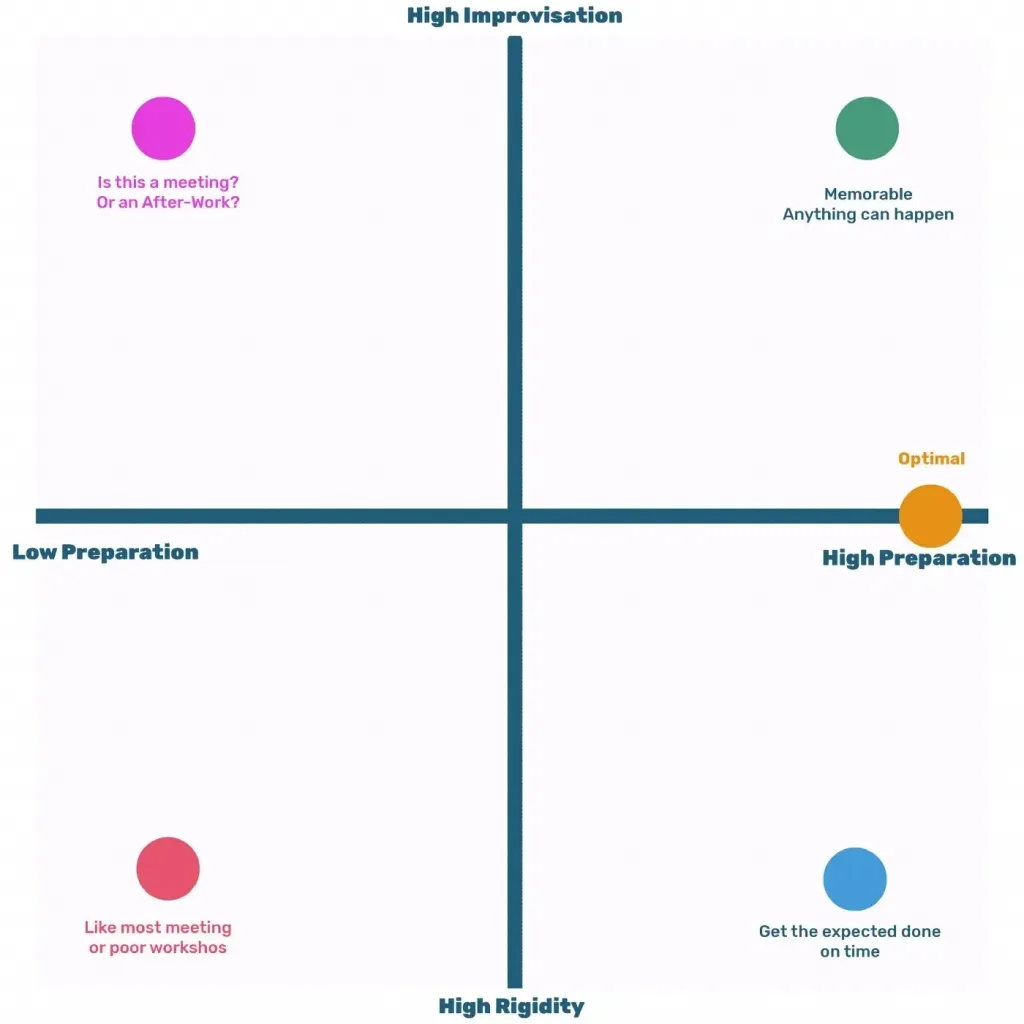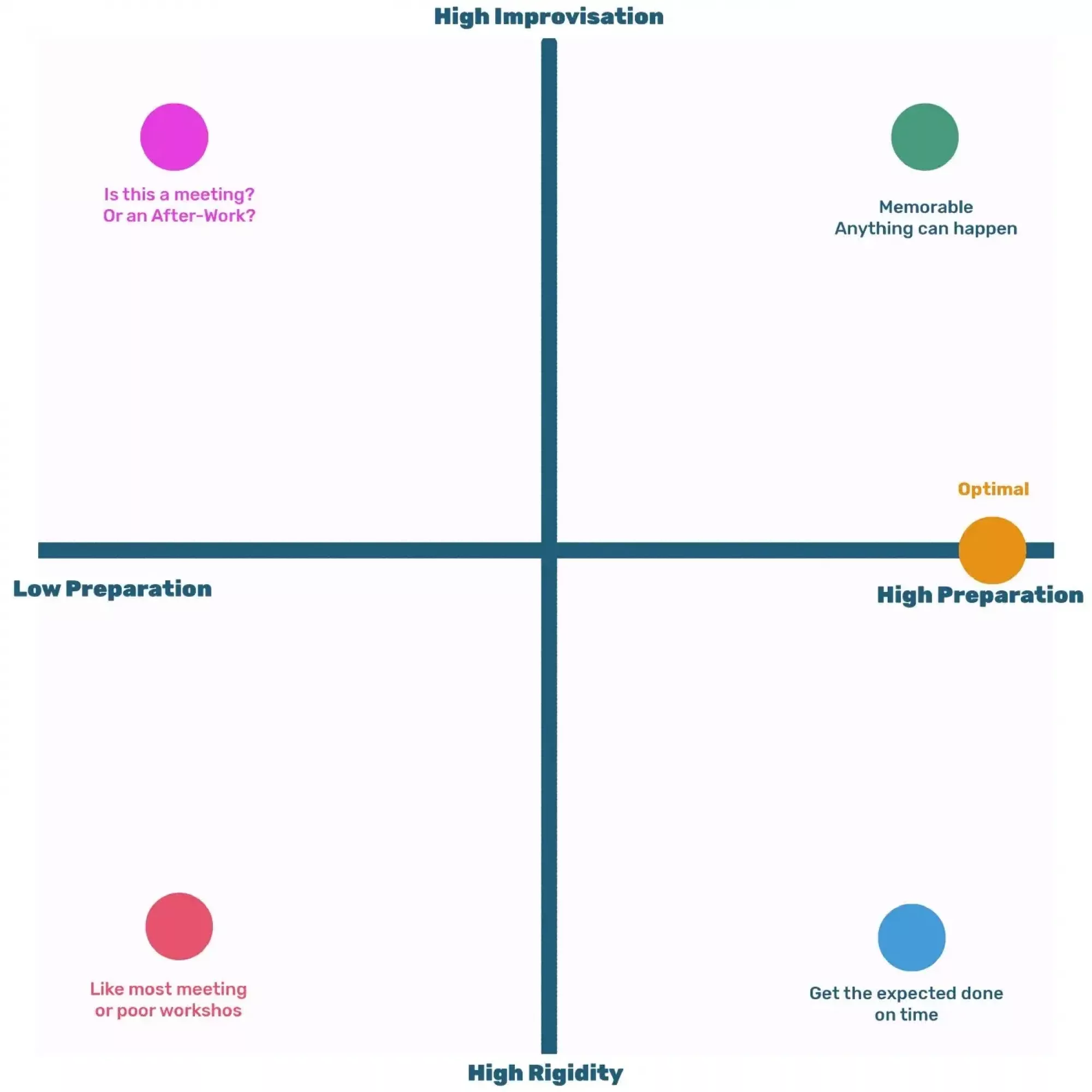
Facilitation Matrix for better workshops or meetings
I’ve been thinking a lot about facilitation and workshops and meetings and why some are so good, and some are poor. I will also freely admit that I seem to pay attention to this more than many others and that there seems to be a surprisingly (even astonishingly) high level of tolerance for poor meetings.
When I think of the best workshops or meetings that I’ve participated in they seem to have certain things in common:
1. The facilitators are highly prepared. They know their stuff and they have a clear, understandable structure that they follow.
2. There’s a high level of flexibility. It means that some unexpected things can happen, and we roll with the punches.
These two things may seem counter intuitive but I believe they are truly the foundation for almost all success.
“Luck Is What Happens When Preparation Meets Opportunity”.
Seneca, Roman Philosopher
I think this is spot on. How would we translate this to workshop and meeting facilitation?
I’ve drawn up this very, very simple matrix, call it the Flexibility/Preparedness Matrix. The X axis measures how prepared you are, from not at all prepared to highly prepared. They Y axis measures how flexible you are, from very rigid to very improvisational.

Low preparedness means there is little to no agreed upon agenda among the facilitators and for the participants. You can see experience this when you see facilitators acting in at cross-purposes. Or when there is no agreed upon definition of what the meeting is about, what is the expected outcome, and when you are supposed to do what (and how).
High preparedness means that the facilitators have a clear purpose and agenda, it is articulated at the beginning and throughout the meeting. High preparedness means that the facilitator or facilitators have done practice run throughs for both the content and the technical aspects. Everyone has a clear role — the facilitators and the participants.
High rigidity means that the facilitator exerts an overwhelming control of the contents of the meeting or workshop, meaning that there is little or no room to find a flow and go with it, or to capture and expand on unexpected opportunities that might pop up. You can see this when facilitators seem not to listen to participants, or whether they even start bickering between themselves.
High improvisation means that the facilitators encourage the participants to drive a lot of the direction of the content. Typically, they can adjust, expand, or retract different parts of the agenda to make room for something new and exciting. Like good improvisational types, they also know when to move on. While there is a lot of room for experimentation this can also feel a little chaotic to some.
I think most of us have been in all of these quadrants. Let’s go counterclockwise from the middle top.
Low preparedness, high improvisation.
These experiences can range from — What are we doing here? to What just happened? These can be good for getting together for a fika or a beer. But if you are actually trying to get something done, you are really rolling the dice.
Low preparedness, high rigidity.
Think of every bad meeting you’ve ever been to. Or a workshop that is unclear, you never get anything done, and that you leave with a lot of worksheets but little understanding of how to use them. You might be in this quandrant.
High preparedness, high rigidity.
These meetings and workshops can be very productive. And they might be very constraining. These are like train-rides — you get on in one destination and get off in another. The ride might be easy, or it might be boring and unfulfilling. But it moves you.
High preparedness, high improvisation.
Imagine a workshop where you experience something completely unexpected. Or where you end up in a completely different place than you expected. Of course, these can feel more emotional than results oriented and might make some people feel a bit uncomfortable.
If I had to choose an optimal spot for a great workshop or meeting, I would choose highly prepared and in between high rigidity and high improvisation. For me, that is the optimal: I get an extremely well-prepared and thought-out structure along with the flexibility to explore and discover unexpected pathways. It shows me that there the workshop will result in some valuable and concrete outcomes but the way there might not be as expected.
High improvisational flexibility requires a higher level of planning and preparedness than typical workshops or meetings because you need to prepare for the unexpected. But really, that is where preparation meets opportunity.
Many of us are good planners. Few of us are good improvisers. We need to be both. As the Herman Miller study said
“The distinguishing characteristic of innovative teams is the fluid, improvisational way they move between activities.”
Try using the Flexibility/Preparedness Matrix as you prepare your next workshop or meeting. Or use it in a post-mortem to identify what you had hoped and what you did. Keep trying to shift where you are in the matrix until you find your sweet spot.
Remember, facilitating workshops and meetings isn’t about you the facilitator; it is only for those who are participating. As a facilitator you have an obligation to make it as engaging and rewarding as possible for everyone who shows up.
/Rich